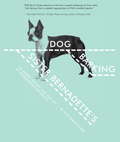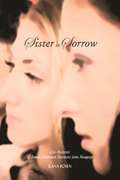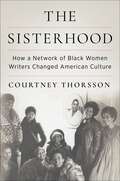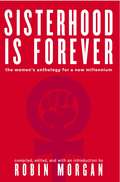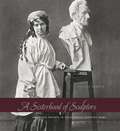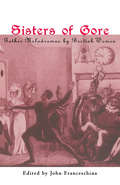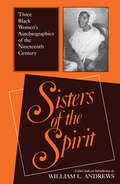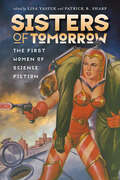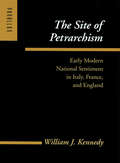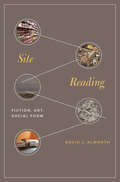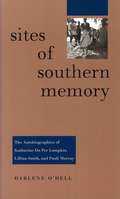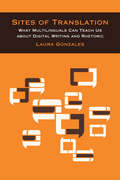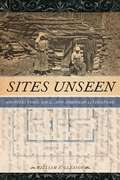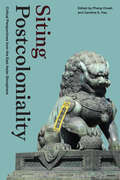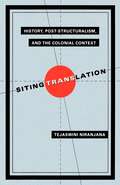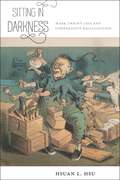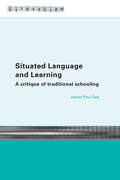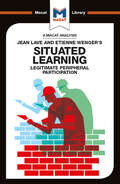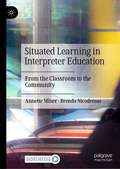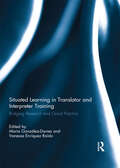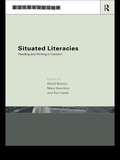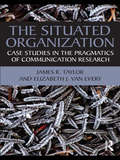- Table View
- List View
Sister Bernadette's Barking Dog
by Kitty Burns FloreyOnce wildly popular in grammar schools across the country, sentence diagramming has fallen out of fashion. But are we that much worse for not knowing the word-mapping method?Now, in this illustrated personal history that any language lover will adore, Kitty Burns Florey explores the rise and fall of sentence diagramming, including its invention by a mustachioed man named Brainerd "Brainy" Kellogg and his wealthy accomplice Alonzo Reed ... the inferior "balloon diagram" predecessor ... and what diagrams of sentences by Hemingway, Welty, Proust, Kerouac and other famous writers reveal about them.Florey also offers up her own common-sense approach to learning and using good grammar. And she answers some of literature's most pressing questions: Was Mark Twain or James Fenimore Cooper a better grammarian? What are the silliest grammar rules? And what's Gertude Stein got to do with any of it?
Sister in Sorrow: Life Histories of Female Holocaust Survivors from Hungary
by Ilana RosenSister in Sorrow offers a glimpse into the world of Hungarian Holocaust survivors through the stories of fifteen survivors, as told by thirteen women and two spouses presently living in Hungary and Israel. Analyzing the accounts as oral narratives, author Ilana Rosen uses contemporary folklore studies methodologies to explore the histories and the consciousness of the narrators as well as the difficulty for present-day audiences to fully grasp them. Rosen's research demonstrates not only the extreme personal horrors these women experienced but also the ways they cope with their memories. In four sections, Rosen interprets the life histories according to two major contemporary leading literary approaches: psychoanalysis and phenomenology. This reading encompasses both the life spans of the survivors and specific episodes or personal narratives relating to the women's identity and history. The psychoanalytic reading examines focal phases in the lives of the women, first in pre-war Europe, then in World War II and the Holocaust, and last as Holocaust survivors living in the shadow of loss and atrocity. The phenomenological examination traces the terms of perception and of the communication between the women and their different present-day non-survivor audiences. An appendix contains the complete life histories of the women, including their unique and affecting remembrances. Although Holocaust memory and narrative have figured at the center of academic, political, and moral debates in recent years, most works look at such stories from a social science perspective and attempt to extend the meaning of individual tales to larger communities. Although Rosen keeps the image of the general group--be it Jews, female Holocaust survivors, Israelis, or Hungarians--in mind throughout this volume, the focus of Sister in Sorrow is the ways the individual women experienced, told, and processed their harrowing experiences. Students of Holocaust studies and women's studies will be grateful for the specific and personal approach of Sister in Sorrow.
The Sisterhood: How a Network of Black Women Writers Changed American Culture
by Courtney ThorssonOne Sunday afternoon in February 1977, Toni Morrison, Alice Walker, Ntozake Shange, and several other Black women writers met at June Jordan’s Brooklyn apartment to eat gumbo, drink champagne, and talk about their work. Calling themselves “The Sisterhood,” the group—which also came to include Audre Lorde, Paule Marshall, Margo Jefferson, and others—would get together once a month over the next two years, creating a vital space for Black women to discuss literature and liberation.The Sisterhood tells the story of how this remarkable community transformed American writing and cultural institutions. Drawing on original interviews with Sisterhood members as well as correspondence, meeting minutes, and readings of their works, Courtney Thorsson explores the group’s everyday collaboration and profound legacy. The Sisterhood advocated for Black women writers at trade publishers and magazines such as Random House, Ms., and Essence, and eventually in academic departments as well—often in the face of sexist, racist, and homophobic backlash. Thorsson traces the personal, professional, and political ties that brought the group together as well as the reasons for its dissolution. She considers the popular and critical success of Sisterhood members in the 1980s, the uneasy absorption of Black feminism into the academy, and how younger writers built on the foundations the group laid. Highlighting the organizing, networking, and community building that nurtured Black women’s writing, this book demonstrates that The Sisterhood offers an enduring model for Black feminist collaboration.
Sisterhood Is Forever: The Women's Anthology for a New Millennium
by Robin MorganThirty years after Robin Morgan's groundbreaking anthology, Sisterhood Is Powerful -- named by The American Librarians' Association one of "The 100 Most Influential Books of the Twentieth Century" -- comes this landmark new collection for the twenty-first century. Sisterhood Is Forever -- with over 60 original essays Morgan commissioned from well-known feminist leaders plus energetic Gen X and Y activists -- is a composite mural of the female experience in America: where we've been, where we are, where we're going. The stunning scope of topics ranges from reproductive, health, and environmental issues to workplace inequities and the economics of women's unpaid labor; from globalization to the politics of aging; from cyberspace, violence against women, and electoral politics to spirituality, the law, the media, and academia. The deliberately audacious mix of contributors spans different generations, races, ethnicities, and sexual preferences: CEOs, housewives, rock stars, farmers, scientists, prostituted women, politicians, women in prison, firefighters, disability activists, artists, flight attendants, an army general, an astronaut, an anchorwoman, even a pair of teens who edit a girls' magazine. Each article celebrates the writer's personal voice -- her humor, passion, anger, and the integrity of her perspective -- while offering the latest data on women's status, political analysis, new "how-to" tools for activism, and visionary yet practical strategies for the future -- strategies needed now more than ever. Robin Morgan's own contributions are everything her readers expect: prophetic, powerfully argued, unsentimentally lyrical. From her introduction: "The book you hold in your hands is a tool for the future -- a future also in your hands." Edna Acosta-Belén Carol J. Adams Margot Adler Natalie Angier Ellen Appel-Bronstein Mary Baird Brenda Berkman Christine E. Bose Kathy Boudin Ellen Bravo Vednita Carter Wendy Chavkin Kimberlé Crenshaw Gail Dines Paula DiPerna Helen Drusine Andrea Dworkin Eve Ensler Barbara Findlen Mary Foley Patricia Friend Theresa Funiciello Carol Gilligan Sara K. Gould Ana Grossman The Guerrilla Girls Beverly Guy-Sheftall Kathleen Hanna Laura Hershey Anita Hill Florence Howe Donna M. Hughes Karla Jay Mae C. Jemison Carol Jenkins Claudia J. Kennedy Alice Kessler-Harris Clara Sue Kidwell Frances Kissling Sandy Lerner Suzanne Braun Levine Barbara Macdonald Catharine A. MacKinnon Jane Roland Martin Debra Michals Robin Morgan Jessica Neuwirth Judy Norsigian Eleanor Holmes Norton Grace Paley Emma Peters-Axtell Cynthia Rich Amy Richards Cecile Richards Carolyn Sachs Marianne Schnall Pat Schroeder Patricia Silverthorn Eleanor Smeal Roslyn D. Smith Gloria Steinem Mary Thom Jasmine Victoria Faye Wattleton Marie Wilson Helen Zia
A Sisterhood of Sculptors: American Artists in Nineteenth-Century Rome
by Melissa DabakisThis project is made possible through support from the Terra Foundation for American Art.When Elizabeth Cady Stanton penned the Declaration of Sentiments for the first women’s rights convention, held in Seneca Falls, New York, in 1848, she unleashed a powerful force in American society. In A Sisterhood of Sculptors, Melissa Dabakis outlines the conditions under which a group of American women artists adopted this egalitarian view of society and negotiated the gendered terrain of artistic production at home and abroad. Between 1850 and 1876, a community of talented women sought creative refuge in Rome and developed successful professional careers as sculptors. Some of these women have become well known in art-historical circles: Harriet Hosmer, Edmonia Lewis, Anne Whitney, and Vinnie Ream. The reputations of others have remained, until now, buried in the historical record: Emma Stebbins, Margaret Foley, Sarah Fisher Ames, and Louisa Lander. At midcentury, they were among the first women artists to attain professional stature in the American art world while achieving international fame in Rome, London, and other cosmopolitan European cities. In their invention of modern womanhood, they served as models for a younger generation of women who adopted artistic careers in unprecedented numbers in the years following the Civil War.At its core, A Sisterhood of Sculptors is concerned with the gendered nature of creativity and expatriation. Taking guidance from feminist theory, cultural geography, and expatriate and postcolonial studies, Dabakis provides a detailed investigation of the historical phenomenon of women’s artistic lives in Rome in the mid-nineteenth century. As an interdisciplinary examination of femininity and creativity, it provides models for viewing and interpreting nineteenth-century sculpture and for analyzing the gendered status of the artistic profession.
A Sisterhood of Sculptors: American Artists in Nineteenth-Century Rome
by Melissa DabakisThis project is made possible through support from the Terra Foundation for American Art.When Elizabeth Cady Stanton penned the Declaration of Sentiments for the first women’s rights convention, held in Seneca Falls, New York, in 1848, she unleashed a powerful force in American society. In A Sisterhood of Sculptors, Melissa Dabakis outlines the conditions under which a group of American women artists adopted this egalitarian view of society and negotiated the gendered terrain of artistic production at home and abroad. Between 1850 and 1876, a community of talented women sought creative refuge in Rome and developed successful professional careers as sculptors. Some of these women have become well known in art-historical circles: Harriet Hosmer, Edmonia Lewis, Anne Whitney, and Vinnie Ream. The reputations of others have remained, until now, buried in the historical record: Emma Stebbins, Margaret Foley, Sarah Fisher Ames, and Louisa Lander. At midcentury, they were among the first women artists to attain professional stature in the American art world while achieving international fame in Rome, London, and other cosmopolitan European cities. In their invention of modern womanhood, they served as models for a younger generation of women who adopted artistic careers in unprecedented numbers in the years following the Civil War.At its core, A Sisterhood of Sculptors is concerned with the gendered nature of creativity and expatriation. Taking guidance from feminist theory, cultural geography, and expatriate and postcolonial studies, Dabakis provides a detailed investigation of the historical phenomenon of women’s artistic lives in Rome in the mid-nineteenth century. As an interdisciplinary examination of femininity and creativity, it provides models for viewing and interpreting nineteenth-century sculpture and for analyzing the gendered status of the artistic profession.
Sisters of Gore: Seven Gothic Melodramas by British Women, 1790-1843 (Garland Reference Library Of The Humanities Ser.)
by John FranceschinaThe plays collected in Sisters of Gore span the development of Gothic melodrama from the 1790s to the 1840s.
Sisters of the Spirit: Three Black Women's Autobiographies of the Nineteenth Century (Religion In North America Ser.)
by William L. Andrews"Sisters of the Spirit . . . should interest a wider audience. . . . These fascinating accounts can stand on their own. . . . Mr. Andrews has made them even more accessible by providing a comprehensive introduction and helpful footnotes . . . but he does not intrude on the text itself." —New York Times Book Review" . . . informative and inspiring reading." —The Journal of American HistoryJarena Lee, Zilpha Elaw, and Julia Foote underwent a revolution in their own sense of self that helped to launch a feminist revolution in American religious life and in American society as a whole.
Sisters of Tomorrow: The First Women of Science Fiction (Early Classics Of Science Fiction Ser.)
by Lisa Yaszek Patrick B. SharpFor nearly half a century, feminist scholars, writers, and fans have successfully challenged the notion that science fiction is all about "boys and their toys," pointing to authors such as Mary Shelley, Clare Winger Harris, and Judith Merril as proof that women have always been part of the genre. Continuing this tradition, Sisters of Tomorrow: The First Women of Science Fiction offers readers a comprehensive selection of works by genre luminaries, including author C. L. Moore, artist Margaret Brundage, and others who were well known in their day, including poet Julia Boynton Green, science journalist L. Taylor Hansen, and editor Mary Gnaedinger. Providing insightful commentary and context, this anthology documents how women in the early twentieth century contributed to the pulp-magazine community and showcases the content they produced, including short stories, editorial work, illustrations, poetry, and science journalism. Yaszek and Sharp's critical annotation and author biographies link women's work in the early science fiction community to larger patterns of feminine literary and cultural production in turn-of-the-twentieth-century America. In a concluding essay, the award-winning author Kathleen Ann Goonan considers such work in relation to the history of women in science and engineering and to the contemporary science fiction community itself.
The Site of Petrarchism: Early Modern National Sentiment in Italy, France, and England (Parallax: Re-visions of Culture and Society)
by William J. KennedyDrawing upon poststructuralist theories of nationalism and national identity developed by such writers as Etienne Balibar, Emmanuel Levinas, Julia Kristeva, Antonio Negri, and Slavoj Zizek, noted Renaissance scholar William J. Kennedy argues that the Petrarchan sonnet serves as a site for early modern expressions of national sentiment in Italy, France, England, Spain, and Germany. Kennedy pursues this argument through historical research into Renaissance commentaries on Petrarch's poetry and critical studies of such poets as Lorenzo de' Medici, Joachim du Bellay and the Pléiade brigade, Philip and Mary Sidney, and Mary Wroth.Kennedy begins with a survey of Petrarch's poetry and its citation in Italy, explaining how major commentators tried to present Petrarch as a spokesperson for competing versions of national identity. He then shows how Petrarch's model helped define social class, political power, and national identity in mid-sixteenth-century France, particularly in the nationalistic sonnet cycles of Joachim Du Bellay. Finally, Kennedy discusses how Philip Sidney and his sister Mary and niece Mary Wroth reworked Petrarch's model to secure their family's involvement in forging a national policy under Elizabeth I and James I.Treating the subject of early modern national expression from a broad comparative perspective, The Site of Petrarchism will be of interest to scholars of late medieval and early modern literature in Europe, historians of culture, and critical theorists.
Site Reading
by David J. AlworthSite Reading offers a new method of literary and cultural interpretation and a new theory of narrative setting by examining five sites--supermarkets, dumps, roads, ruins, and asylums--that have been crucial to American literature and visual art since the mid-twentieth century. Against the traditional understanding of setting as a static background for narrative action and character development, David Alworth argues that sites figure in novels as social agents. Engaging a wide range of social and cultural theorists, especially Bruno Latour and Erving Goffman, Site Reading examines how the literary figuration of real, material environments reorients our sense of social relations. To read the sites of fiction, Alworth demonstrates, is to reveal literature as a profound sociological resource, one that simultaneously models and theorizes collective life.Each chapter identifies a particular site as a point of contact for writers and artists--the supermarket for Don DeLillo and Andy Warhol; the dump for William Burroughs and Mierle Laderman Ukeles; the road for Jack Kerouac, Joan Didion, and John Chamberlain; the ruin for Thomas Pynchon and Robert Smithson; and the asylum for Ralph Ellison, Gordon Parks, and Jeff Wall--and shows how this site mediates complex interactions among humans and nonhumans. The result is an interdisciplinary study of American culture that brings together literature, visual art, and social theory to develop a new sociology of literature that emphasizes the sociology in literature.
Sites of Southern Memory: The Autobiographies of Katharine Du Pre Lumpkin, Lillian Smith, and Pauli Murray
by Darlene O'DellIn southern graveyards through the first decades of the twentieth century, the Confederate South was commemorated by tombstones and memorials, in Confederate flags, and in Memorial Day speeches and burial rituals. Cemeteries spoke the language of southern memory, and identity was displayed in ritualistic form--inscribed on tombs, in texts, and in bodily memories and messages. Katharine DuPre Lumpkin, Lillian Smith, and Pauli Murray wove sites of regional memory, particularly Confederate burial sites, into their autobiographies as a way of emphasizing how segregation divided more than just southern landscapes and people.Darlene O'Dell here considers the southern graveyard as one of three sites of memory--the other two being the southern body and southern memoir--upon which the region's catastrophic race relations are inscribed. O'Dell shows how Lumpkin, Smith, and Murray, all witnesses to commemorations of the Confederacy and efforts to maintain the social order of the New South, contended through their autobiographies against Lost Cause versions of southern identity. Sites of Southern Memory elucidates the ways in which these three writers joined in the dialogue on regional memory by placing the dead southern body as a site of memory within their texts. In this unique study of three women whose literary and personal lives were vitally concerned with southern race relations and the struggle for social justice, O'Dell provides a telling portrait of the troubled intellectual, literary, cultural, and social history of the American South.
Sites of Translation: What Multilinguals Can Teach Us about Digital Writing and Rhetoric (Sweetland Digital Rhetoric Collaborative)
by Laura GonzalesWinner of the 2016 Sweetland Digital Rhetoric Collaborative Book Prize Sites of Translation illustrates the intricate rhetorical work that multilingual communicators engage in as they translate information for their communities. Blending ethnographic and empirical methods from multiple disciplines, Laura Gonzales provides methodological examples of how linguistic diversity can be studied in practice, both in and outside the classroom, and provides insights into the rhetorical labor that is often unacknowledged and made invisible in multilingual communication. Sites of Translation is relevant to researchers and teachers of writing as well as technology designers interested in creating systems, pedagogies, and platforms that will be more accessible and useful to multilingual audiences. Gonzales presents multilingual communication as intellectual labor that should be further valued in both academic and professional spaces, and supported by multilingual technologies and pedagogies that center the expertise of linguistically diverse communicators.
Sites Unseen: Architecture, Race, and American Literature (America and the Long 19th Century #23)
by William A. GleasonSites Unseen examines the complex intertwining of race and architecture in nineteenth and early-twentieth century American culture, the period not only in which American architecture came of age professionally in the U.S. but also in which ideas about architecture became a prominent part of broader conversations about American culture, history, politics, and—although we have not yet understood this clearly—race relations. This rich and copiously illustrated interdisciplinary study explores the ways that American writing between roughly 1850 and 1930 concerned itself, often intensely, with the racial implications of architectural space primarily, but not exclusively, through domestic architecture.In addition to identifying an archive of provocative primary materials, Sites Unseen draws significantly on important recent scholarship in multiple fields ranging from literature, history, and material culture to architecture, cultural geography, and urban planning. Together the chapters interrogate a variety of expressive American vernacular forms, including the dialect tale, the novel of empire, letters, and pulp stories, along with the plantation cabin, the West Indian cottage, the Latin American plaza, and the "Oriental" parlor. These are some of the overlooked plots and structures that can and should inform a more comprehensive consideration of the literary and cultural meanings of American architecture. Making sense of the relations between architecture, race, and American writing of the long nineteenth century—in their regional, national, and hemispheric contexts—Sites Unseen provides a clearer view not only of this catalytic era but also more broadly of what architectural historian Dell Upton has aptly termed the social experience of the built environment.
Siting Postcoloniality: Critical Perspectives from the East Asian Sinosphere (Sinotheory)
by Pheng Cheah and Caroline S. HauThe contributors to Siting Postcoloniality reevaluate the notion of the postcolonial by focusing on the Sinosphere—the region of East and Southeast Asia that has been significantly shaped by relations with China throughout history. Pointing out that the history of imperialism in China and Southeast Asia is longer and more complex than Euro-American imperialism, the contributors complicate the traditional postcolonial binaries of center-periphery, colonizer-colonized, and developed-developing. Among other topics, they examine socialist China’s attempts to break with Soviet cultural hegemony, the postcoloniality of Taiwan as it negotiates the legacy of Japanese colonial rule, Southeast Asian and South Asian diasporic experiences of colonialism, and Hong Kong’s complex colonial experiences under the British, the Japanese, and mainland China. The contributors show how postcolonial theory’s central concepts cannot adequately explain colonialism in the Sinosphere. Challenging fundamental axioms of postcolonial studies, the volume forcefully suggests that postcolonial theory needs to be rethought.Contributors. Pheng Cheah, Dai Jinhua, Caroline S. Hau, Elaine Yee Lin Ho, Wendy Larson, Liao Ping-hui, Lin Pei-yin, Lo Kwai-Cheung, Lui Tai-lok, Pang Laikwan, Lisa Rofel, David Wang, Erebus Wong, Robert J. C. Young
Siting Translation: History, Post-Structuralism, and the Colonial Context
by Tejaswini NiranjanaThe act of translation, Tejaswini Niranjana maintains, is a political action. Niranjana draws on Benjamin, Derrida, and de Man to show that translation has long been a site for perpetuating the unequal power relations among peoples, races, and languages. The traditional view of translation underwritten by Western philosophy helped colonialism to construct the exotic "other" as unchanging and outside history, and thus easier both to appropriate and control.Scholars, administrators, and missionaries in colonial India translated the colonized people's literature in order to extend the bounds of empire. Examining translations of Indian texts from the eighteenth century to the present, Niranjana urges post-colonial peoples to reconceive translation as a site for resistance and transformation.
Sitting in Darkness: Mark Twain's Asia and Comparative Racialization (America and the Long 19th Century #7)
by Hsuan L. HsuPerhaps the most popular of all canonicalAmerican authors, Mark Twain is famous for creating works that satirizeAmerican formations of race and empire. While many scholars have exploredTwain’s work in African Americanist contexts, his writing on Asia and AsianAmericans remains largely in the shadows. In Sitting in Darkness, Hsuan Hsuexamines Twain’s career-long archive of writings about United States relationswith China and the Philippines. Comparing Twain’s early writings about Chineseimmigrants in California and Nevada with his later fictions of slavery andanti-imperialist essays, he demonstrates that Twain’s ideas about race were notlimited to white and black, but profoundly comparative as he carefully craftedassessments of racialization that drew connections between groups, includingAfrican Americans, Chinese immigrants, and a range of colonial populations.Drawing on recent legal scholarship,comparative ethnic studies, and transnational and American studies, Sitting inDarkness engages Twain’s best-known novels such as Tom Sawyer, HuckleberryFinn, and A Connecticut Yankee in King Arthur’s Court, as well as hislesser-known Chinese and trans-Pacific inflected writings, such as theallegorical tale “A Fable of the Yellow Terror” and the yellow face play AhSin. Sitting in Darkness reveals how within intersectional contexts of ChineseExclusion and Jim Crow, these writings registered fluctuating connectionsbetween immigration policy, imperialist ventures, and racism.
Sitton Spelling And Word Skills Practice Book 3: Level 3 The Zoo
by Rebecca SittonSpelling Practice Book For Grade 3
Sitton Spelling and Word Skills Practice Book 4
by Rebecca Sitton Donna BernardNIMAC-sourced textbook
Situated Language and Learning: A Critique of Traditional Schooling (Literacies)
by James Paul GeeWhy do poor and minority students under-perform in school? Do computer games help or hinder learning? What can new research in psychology teach our educational policy-makers?In this major new book, Gee tackles the 'big ideas' about language, literacy and learning, putting forward an integrated theory that crosses disciplinary boundaries, and applying it to some of the very real problems that face educationalists today.Situated Language and Learning looks at the specialist academic varieties of language that are used in disciplines such as mathematics and the sciences. It argues that the language acquisition process needed to learn these forms of language is not given enough attention by schools, and that this places unfair demands on poor and minority students.The book compares this with learning as a process outside the classroom, applying this idea to computer and video games, and exploring the particular processes of learning which take place as a child interacts with others and technology to learn and play. In doing so, Gee examines what video games can teach us about how to improve learning in schools and engages with current debates on subjects such as 'communities of practice' and 'digital literacies'.Bringing together the latest research from a number of disciplines, Situated Language and Learning is a bold and controversial book by a leading figure in the field, and is essential reading for anyone interested in education and language.
Situated Learning: Legitimate Peripheral Participation (The Macat Library)
by Charmi PatelSocial anthropologist Jean Lave and computer scientist Etienne Wenger’s seminal Situated Learning helped change the fields of cognitive science and pedagogy by approaching learning from a novel angle. Traditionally, theories of learning and education had focused on processes of cognition – the mental processes of knowledge formation that occur within an individual. Lave and Wenger chose to look at learning not as an individual process, but a social one. As so often with the creative thinking process, a small, simple shift in emphasis was all that was required to show things in an entirely different light. What Situated Learning illustrated – and emphasized – was that learning is dependent on its social situation. Even though the most effective way to learn is through interaction with experts and peers in a community organized around a common interest, the traditional cognitive learning model failed to account for the way in which learners interact with their ‘community of practice.’ The new hypothesis that Lave and Wenger developed was that learning can be seen as a continuously evolving set of relationships situated within a social context. This allowed Lave and Wenger to place discussions of apprenticeship and workplace learning on a new footing – and led in turn to the book’s impressive impact in business and management scholarship.
Situated Learning in Interpreter Education: From the Classroom to the Community
by Annette Miner Brenda NicodemusThis book provides a theoretical and pragmatic guide to the use of situated learning within structured interpreting programs. Proponents of situated learning theory believe that meaningful learning occurs when students interact with others in the social contexts in which they will be working. With such interactions, students have the opportunity to apply their theoretical knowledge to authentic contexts that they will encounter throughout their professional lives. While a limited number of research articles exist about the use of situated learning in interpreter education, this is the first full book to provide the foundations for situated learning theory, show how to implement situated learning in interpreter education, and offer practical applications for maximizing authenticity in interpreting classrooms.
Situated Learning in Translator and Interpreter Training: Bridging research and good practice
by Maria González-Davies and Vanessa Enríquez RaídoSituated Learning is generally understood as a context-dependent approach to translator and interpreter training under which learners are exposed to real-life and/or highly simulated collaborative work environments and tasks, both inside and outside the classroom. Ultimately, Situated Learning seeks to enhance learners’ capacity to think and act like professionals. This book sets out to gauge the extent to which different factors influence the implementation of Situated Learning models in various teaching and learning contexts. It presents an understanding of Situated Learning that goes beyond previous interpretations of this notion, traditionally dominated by the discussion of pedagogical practices in authentic, i.e. real-world, or semi-authentic professional settings. This wider remit of Situated Learning encompasses previously underrepresented contextual factors pertaining to translation traditions, historical trends, community beliefs and customs, socio-economic constraints, market conditions, institutional practices, budgetary issues, or resource availability. The pedagogical considerations of these key aspects make this book particularly useful for both novice and seasoned teachers of translation and interpreting with an interest in informed practical advice on how to implement the principles of Situated Learning in collaborative teaching and learning environments that seek to promote translators’ and/or interpreters’ professional competence. This book was originally published as a special issue of The Interpreter and Translator Trainer.
Situated Literacies: Theorising Reading and Writing in Context (Literacies)
by David Barton Mary Hamilton Roz IvaničSituated Literacies is a rich and varied collection of key writings from leading international scholars in the field of literacy. Each contribution, written in a clear, accessible style, makes the link between literacies in specific contexts and broader social practices.Detailed ethnographic studies of a wide variety of specific situations, all involving real texts and lived practices, are balanced with general claims about the nature of literacy. Contributors address a coherent set of issues:* the visual and material aspects of literacy* concepts of time and space in relation to literacy* the functions of literacies in shaping and sustaining identities in communities of practice* the relationship between texts and the practices associated with their usethe role of discourse analysis on literacy studiesThese studies, along with a foreword by Denny Taylor, make a timely and important contribution to literacy theory and suggest directions for the further development of the field. Situated Literacies is essential reading for anyone involved in literary education.
The Situated Organization: Case Studies in the Pragmatics of Communication Research
by James R. Taylor Elizabeth J. Van EveryThe Situated Organization explores recent research in organizational communication, emphasizing the organization as constructed in and emerging out of communication practices. Working from the tradition of the Montreal School in its approach, it focuses not only on how an organization’s members understand the purposes of the organization through communication, but also on how they realize and recognize the organization itself as they work within it. The text breaks through with an alternative viewpoint to the currently popular idea of 'organization-as-network,' viewing organization instead as a configuration of agencies, and their fields of practice. It serves as an original, comprehensive, and well-written text, elaborated by case studies that make the theory come to life. The substantial ideas and insights are presented in a deep and meaningful way while remaining comprehensible for student readers. This text has been developed for students at all levels of study in organizational communication, who need a systematic introduction to conducting empirical field research. It will serve as an invaluable sourcebook in planning and conducting research.
